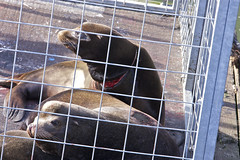 CORVALLIS, Ore. – A new study by researchers at Oregon State University’s Marine Mammal Institute suggests most entanglements of Steller sea lions in human-made marine debris along the Pacific coast could be prevented through education and changes to manufacturing and packaging processes when the entangling materials are produced.
CORVALLIS, Ore. – A new study by researchers at Oregon State University’s Marine Mammal Institute suggests most entanglements of Steller sea lions in human-made marine debris along the Pacific coast could be prevented through education and changes to manufacturing and packaging processes when the entangling materials are produced.
In the first study of its kind in the Pacific Northwest, Kim Raum-Suryan, an OSU faculty research assistant, studied Steller sea lions between 2005 and 2009 at two of Oregon’s most iconic locations, the Sea Lion Caves and Cascade Head. Steller sea lions use these as “haul-outs,” places where the mammals rest on land between feeding forays.
Over the past 30 years, the Steller sea lion population has declined by more than 80 percent, resulting in its threatened status in the eastern portion of its range (central California to southeast Alaska) and endangered status in the western portion (western Alaska).
During the study, which was completed with funding from Oregon Sea Grant, Raum-Suryan witnessed 72 animals entangled in debris including: black rubber bands used on crab pots; hard plastic packing bands used around cardboard bait boxes (and other cardboard shipping boxes); and hooks and other fishing gear.
